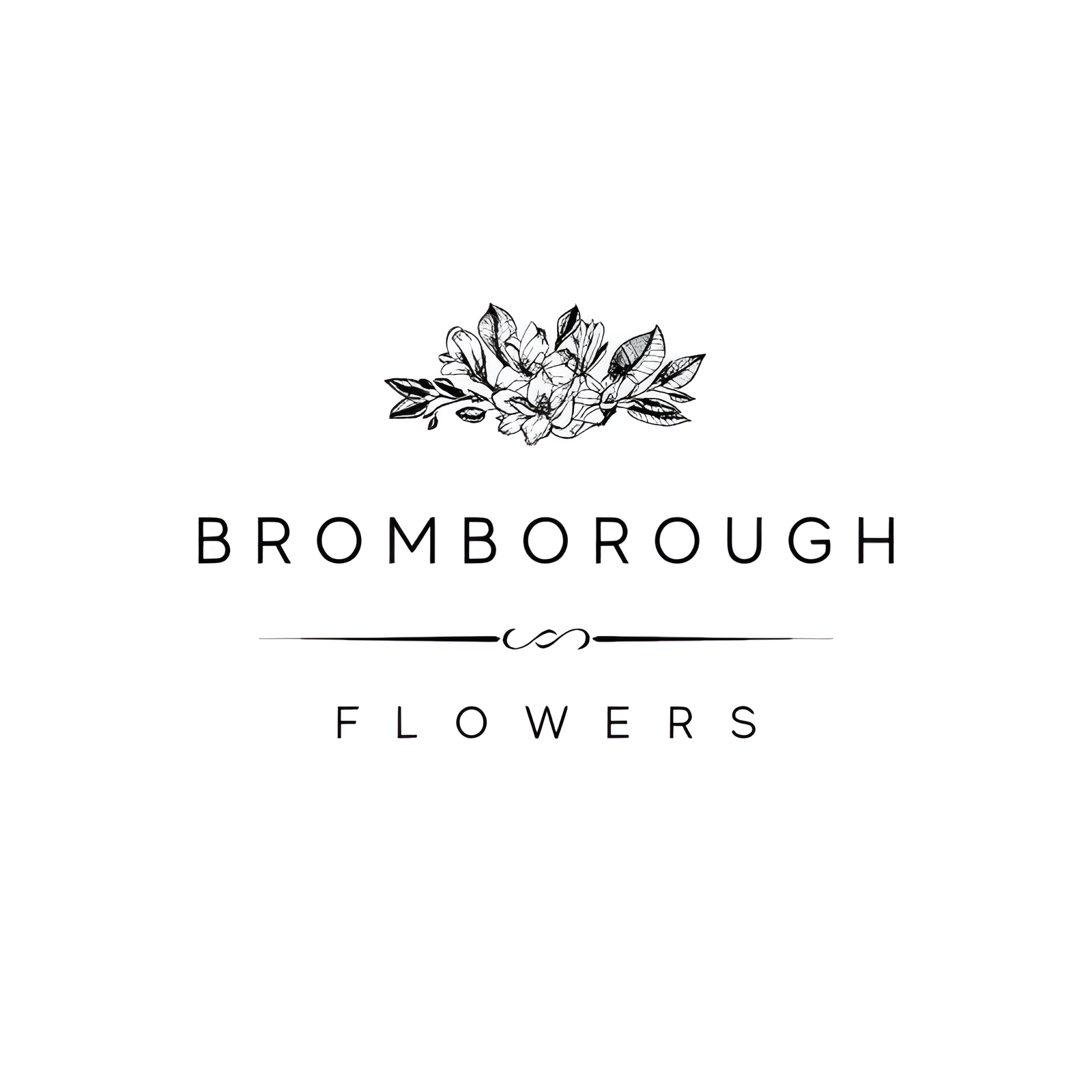In the domain of wedding florals, the sunflower stands out not only for its vibrant yellow petals but also for its deep symbolic meaning of positivity and happiness. Its affordability and versatility make it an attractive option for many couples. Whether incorporated into a rustic bouquet, used as a striking centerpiece, or woven into a summer-themed wedding arch, the sunflower offers a unique blend of charm and warmth. But what truly sets this bloom apart is its rich cultural heritage and adaptability to various themes and color palettes, elements that make it a fascinating topic to explore further.
Flower Overview
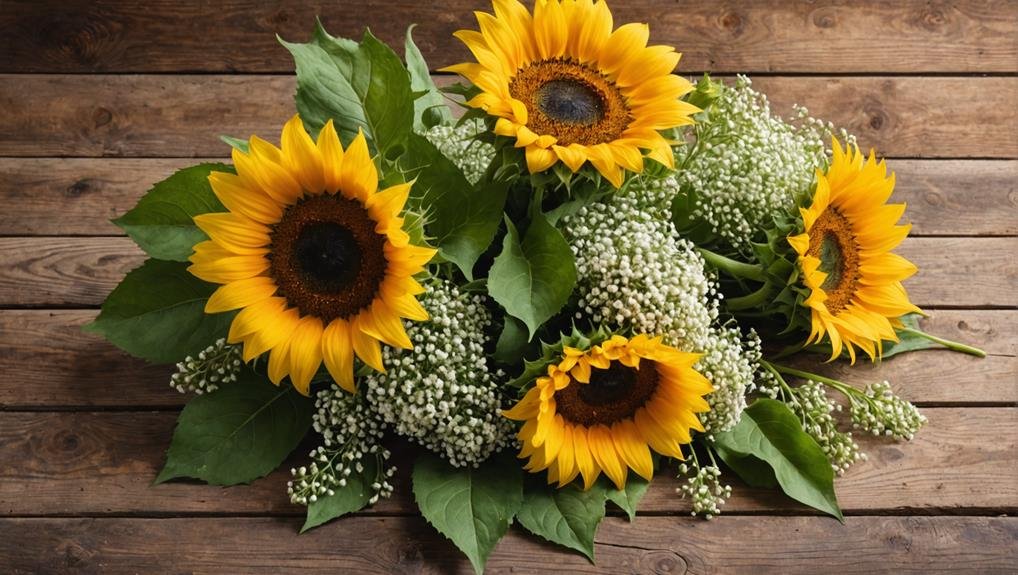
Why are sunflowers an ideal choice for wedding bouquets?
As a wedding flower, the sunflower brings a vibrant touch of yellow to any floral arrangement, symbolizing positivity, optimism, happiness, and abundance. Its cheerful hue makes it a perfect fit for summer weddings, where its bright and sunny disposition can enhance the overall aesthetic of the celebration. Sunflower bouquets offer a natural rustic charm, adding dimension and a fresh look to the event.
One of the primary reasons sunflowers are favored for wedding bouquets is their versatility. They can seamlessly blend with a variety of other flowers such as roses, dahlias, and succulents, creating unique and personalized arrangements. From dreamy wildflower bundles to more eclectic and colorful designs, sunflowers can adapt to various styles, catering to diverse tastes and preferences.
Furthermore, sunflowers are an affordable option, allowing couples to achieve a stunning floral display without straining their wedding budget.
The combination of affordability, vibrant color, and cultural symbolism makes sunflowers an excellent choice for brides and grooms seeking to infuse their special day with joy and warmth.
Physical Description
Sunflowers, characterized by their large, vibrant yellow petals and dark centers, are renowned for their striking resemblance to the sun. These flowers are a standout choice for Sunflower Wedding Bouquets, adding a rustic vibe and a visually striking element to any floral arrangement. Typically, a large sunflower can grow up to 12 feet tall, with flower heads reaching up to 12 inches in diameter, making them a bold statement piece in wedding décor.
Belonging to the genus Helianthus and native to North and South America, sunflowers are uniquely composed of hundreds of tiny individual flowers clustered together in a spiral pattern within their central disk. This intricate structure not only enhances their visual appeal but also contributes to their symbolic association with positivity, happiness, and longevity—qualities highly cherished in wedding celebrations.
The bright yellow petals of sunflowers make them an excellent choice for couples seeking a warm, inviting atmosphere. When incorporated into wedding bouquets, these flowers can elevate the overall aesthetic, providing a cheerful and rustic vibe that complements a variety of wedding themes. Their ability to track the sun further underscores their dynamic presence, making them a memorable addition to any wedding floral arrangement.
Available Colour Varieties
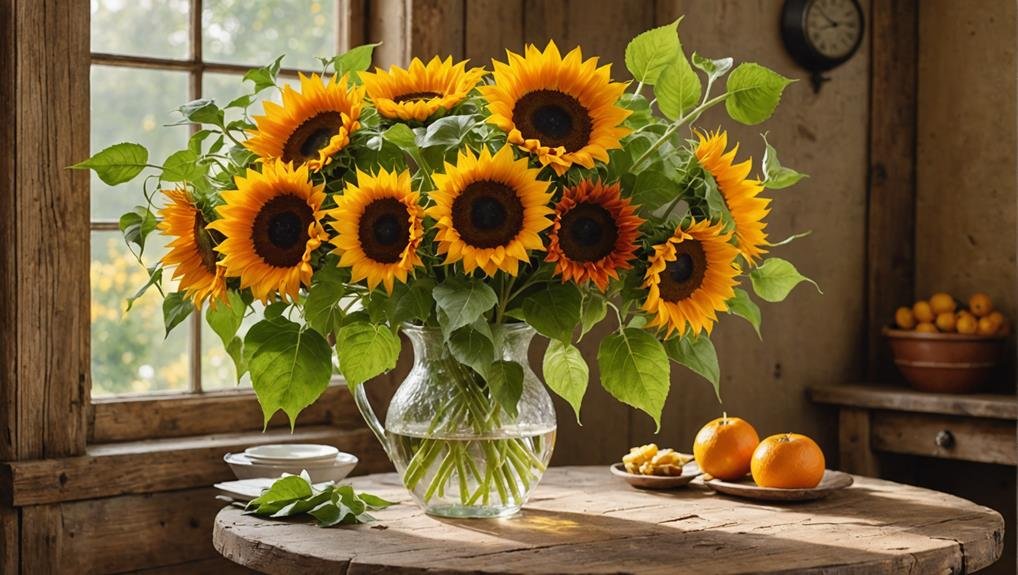
Available in an array of vibrant hues, sunflowers offer diverse color varieties that can enhance and tailor wedding floral arrangements to specific themes and moods. The traditional yellow sunflower remains a popular choice, symbolizing joy and happiness. However, sunflowers are available in an impressive range of other colors, such as bright orange, deep burgundy, and even multicolored options, offering a visually appealing palette for diverse bouquet selection.
For those seeking more unique shades, sunflowers also come in peach, fuchsia, lilac, and burnt orange. These diverse color varieties allow for the creation of arrangements that can evoke specific moods, from vibrant and cheerful to romantic and dramatic. Pairing sunflowers with complementary colors like white, purple, and lavender further enhances their visual appeal, creating sophisticated and harmonious designs.
In addition, sunflowers can be incorporated into specific color themes such as pastels, brights, or burgundy, providing versatility for matching various wedding palettes and themes. This adaptability makes sunflowers an excellent choice for weddings, offering endless possibilities to create memorable and aesthetically pleasing floral arrangements.
Latin Name and Taxonomy
Understanding the Latin name and taxonomy of sunflowers, Helianthus annuus, offers valuable insights into their botanical characteristics and growth patterns. The Latin name, Helianthus annuus, is derived from Greek, where ‘Helios’ means sun and ‘anthos’ means flower, aptly reflecting the sunflower’s natural orientation towards sunlight.
As a member of the Asteraceae family, sunflowers share common traits with other composite flowers, characterized by a central disc surrounded by florets. The taxonomy of sunflowers encompasses a variety of types, including dwarf, branching, and decorative varieties. These classifications help horticulturists and florists select the most appropriate sunflower types for different purposes, such as weddings or garden displays.
Each variety exhibits unique botanical characteristics, such as height, branching patterns, and petal arrangements, which can influence their growth patterns and adaptability to different environments. Sunflowers’ botanical characteristics include their ability to grow in a range of soil types and climates, making them versatile additions to floral arrangements.
Their robust stems, large leaves, and vibrant yellow petals not only add visual appeal but also signify the plant’s hardiness and resilience. Understanding the taxonomy and Latin name of Helianthus annuus, therefore, provides a foundation for appreciating their diverse applications in floral design.
Geographical Origins
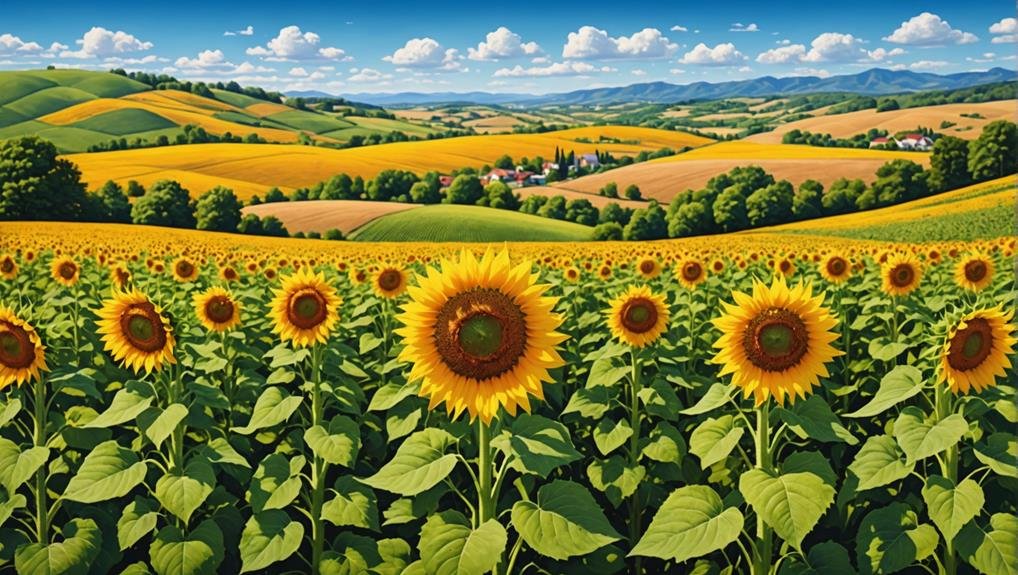
Originating in the western United States, sunflowers are native to North and South America and have a rich history of domestication by Native Americans around 1000 B.C. for their seeds and oil. These indigenous communities recognized the value of sunflowers early on, utilizing them for nutritional and medicinal purposes. The plant’s ability to thrive in various climates made it a staple in their agricultural practices.
Sunflowers’ journey to global prominence began in the 16th century when Spanish explorers introduced them to Europe. The plant’s striking appearance and usefulness quickly garnered attention, leading to widespread cultivation across the continent. Over time, sunflowers spread globally, finding their way to different regions where they became integrated into local agricultural systems.
Today, sunflowers are cultivated extensively in temperate climates with full sun and well-drained soil, contributing significantly to the economies of several countries. Ukraine, Russia, Argentina, and the United States are among the top producers, each harnessing the plant’s versatility for oil production and other uses.
The global spread of sunflowers underscores their adaptability and enduring appeal, making them a beloved choice for various applications, including weddings and other celebrations.
Season Availability
Sunflowers reach their peak season in late summer, typically from September to October, offering the best quality and value for floral arrangements. This period is particularly advantageous for those planning sunflowers for weddings, as the flowers are at their most vibrant and robust. Utilizing sunflowers during their peak season ensures not only superior quality but also more reasonable pricing, making them an economical choice for large-scale floral needs.
Seasonal availability is an essential factor to ponder when planning wedding decor. During late summer, sunflowers are abundantly available, which translates to lower costs and better quality blooms. This timing allows for the creation of stunning, naturalistic floral arrangements that can enhance the aesthetic appeal of any wedding setting.
Moreover, selecting sunflowers during their prime season minimizes the risk of encountering subpar blooms, which can detract from the overall visual impact of the arrangements.
Growing Conditions
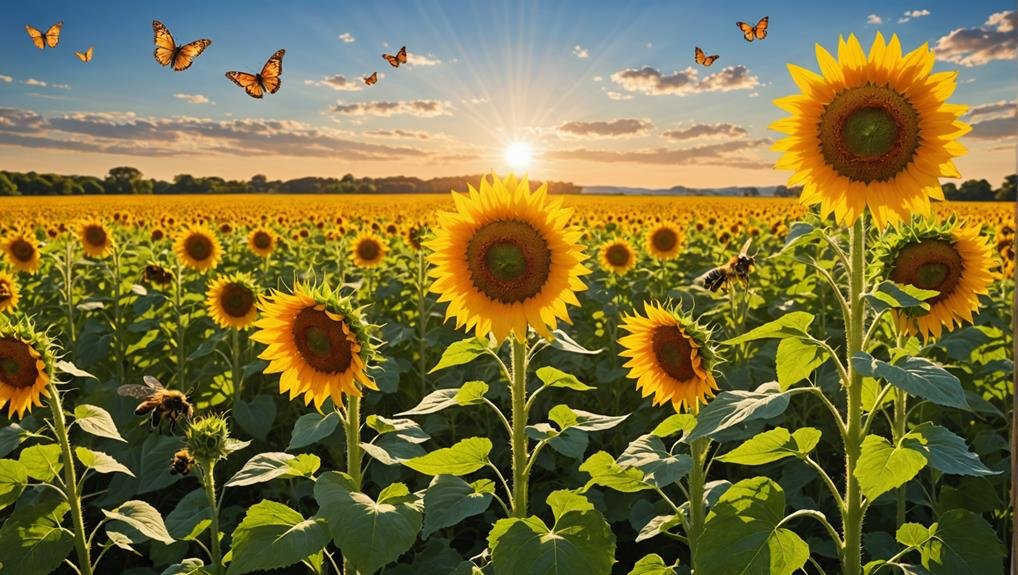
Optimal growing conditions for sunflowers include a minimum of 6-8 hours of direct sunlight daily and well-drained soil with a pH range of 6.0 to 7.5. Sunflowers are sun-loving plants that thrive in full sun, making them an excellent choice for gardeners with ample light exposure.
Ensuring that the soil is well-drained is vital, as this prevents waterlogging and promotes healthy root development.
Once established, sunflowers are notably drought-resilient, which makes them suitable for regions with dry spells. However, regular watering is crucial during the initial growth stages to help develop a strong root system.
Planting sunflower seeds directly in the ground after the last frost date in your area is recommended to avoid any damage from cold weather.
Cultural Significance
Across various cultures, sunflowers embody profound symbolism, often representing positivity, optimism, and happiness. Their bright yellow petals and sun-like appearance make them a universal symbol of joy and warmth, qualities that are particularly cherished in the context of a wedding.
In Chinese culture, sunflowers are revered for their association with enduring joy and abundance. They symbolize good luck and a prosperous future, which are desirable blessings for newlyweds. Native American belief systems also imbue sunflowers with significant meaning, linking them to abundance, fertility, and a bountiful harvest. These associations make sunflowers a meaningful choice for wedding arrangements, reflecting the couple’s hopes for a prosperous and happy union.
To summarize the cultural significance of sunflowers in weddings, we can look at the following key attributes:
| Culture | Symbolism |
|---|---|
| Chinese | Joy, abundance, good luck |
| Native American | Abundance, fertility |
| General | Positivity, optimism, happiness |
The rich cultural significance of sunflowers adds depth to wedding floral arrangements. Their symbolism of happiness, optimism, and abundance resonates with the aspirations of many couples, making them an ideal choice for those seeking to infuse their special day with meaningful traditions.
Typical Use in Weddings
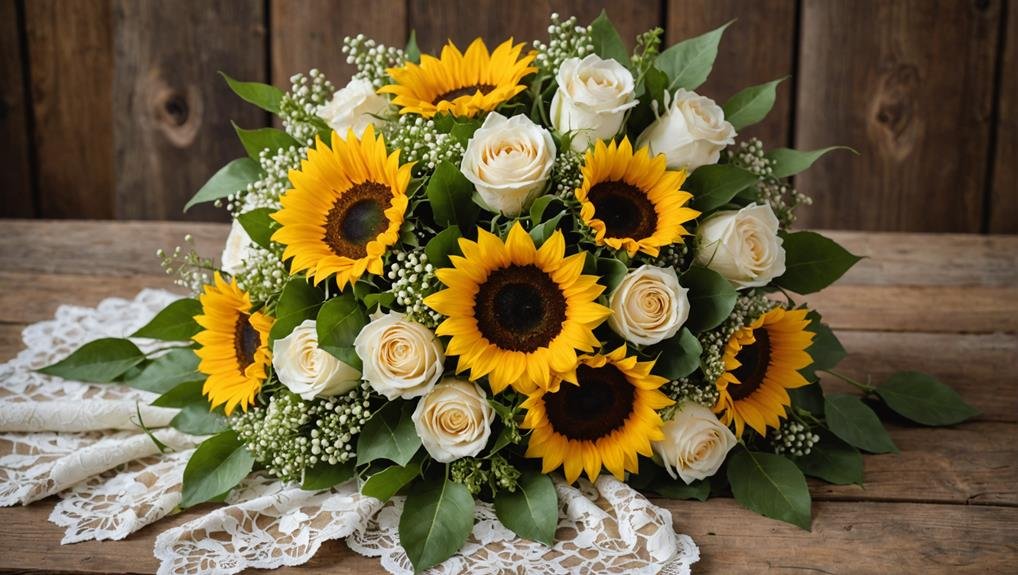
Incorporating sunflowers into wedding arrangements offers a vibrant and versatile option that aligns well with various wedding themes and seasons. Celebrated for their symbolism of positivity, happiness, and abundance, sunflowers are particularly popular in summer and fall weddings. Their bright hues and natural aesthetic make them a fitting choice for couples seeking to infuse their celebrations with a touch of nature’s brilliance.
A sunflower wedding bouquet can serve as a striking focal point, whether it stands alone or is paired with other wedding flowers. Floral designers often recommend sunflowers for their ability to complement diverse color schemes and enhance a wide range of wedding themes. From rustic feel to more elegant settings, sunflowers can be styled to suit different bridal visions.
Sunflowers are not only visually appealing but also an affordable choice, making them ideal for budget-conscious couples. Their versatility allows them to be incorporated into various bouquet styles, from wild and organic to structured and romantic. This adaptability helps couples achieve a cohesive look that resonates with their personal tastes and the overall atmosphere of their wedding day.
Alternative Flower Types
When planning wedding flower arrangements, considering alternative flower types such as dahlias, roses, and phlox can offer diverse aesthetic options to suit various themes and preferences. These flowers each bring their unique charm and can complement a wide variety of wedding styles.
Dahlias are known for their rich colors and intricate petal arrangements, making them a striking choice for bouquets and centerpieces. Roses, with their timeless elegance, can easily fit into both traditional and contemporary wedding themes. Phlox, with its delicate clusters of blooms, adds a softness and romantic touch to any floral arrangement. Additionally, incorporating native florals can provide a more personalized and locally-sourced feel to your wedding decor.
Combining sunflowers with other alternative flower types can create a unique and visually appealing bouquet. For example, pairing sunflowers with daisies, dahlias, and tiny buds can add texture and depth. Here is a comparison of some popular alternative flowers and their features:
| Flower Type | Key Features |
|---|---|
| Dahlias | Rich colors, intricate petal design |
| Roses | Timeless elegance, versatile |
| Phlox | Delicate clusters, romantic |
| Native Florals | Personalized, locally-sourced |
| Daisies | Simple charm, bright and cheerful |
